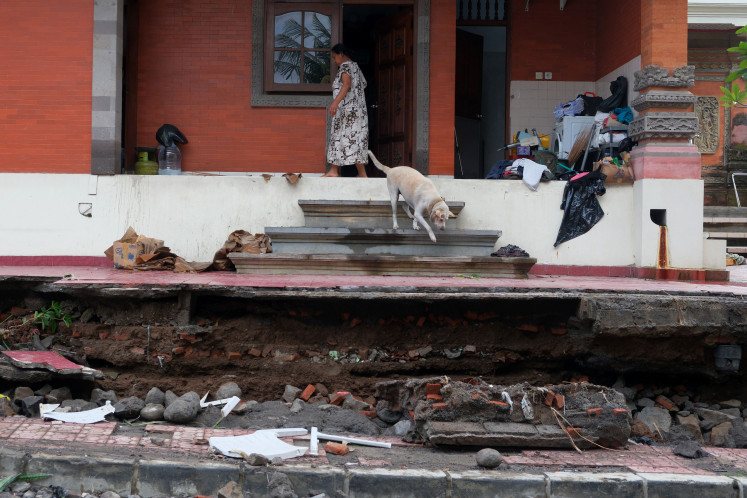Popular Reads
Top Results
Can't find what you're looking for?
View all search resultsPopular Reads
Top Results
Can't find what you're looking for?
View all search resultsTempeh fever in Wollongong
A couple was busy cooking in their small kitchen
Change text size
Gift Premium Articles
to Anyone
A
couple was busy cooking in their small kitchen. Jendra S. Wardani, 34, put yeast into a large container of soybeans and stirred skillfully while her husband, Djarot B. Darmani, 43, prepared the plastic packages.
Working together, they placed the concoction into the packages.
The couple was making tempeh in their rented apartment just opposite Wollongong University in Australia. Their only child, five-year-old Bima Bening Mardiono, was busy playing in the living room, which becomes a bedroom at night.
“This is our life in Australia. A simple life,” said Djarot, an engineering lecturer at Brawijaya University in Malang, East Java, specializing in steel welding research.
“The label may sound fancy — studying abroad to get my Ph.D.,” he said, referring to the image of people studying overseas.
The idea to produce tempeh began even before Jendra left for Wollongong to join her husband. “It’s a business opportunity. I asked people in Malang to find the best recipe to make tempeh before leaving for Australia. I wrote down all of the recipes,” she said.
According to Jendra, she got the idea after reading the novel Ketika Cinta Bertasbih (When Love is Glorified), a novel that tells of Indonesian students who made tempeh while studying in Cairo.
“I was thinking, why can’t I do the same?” she says.
Djarot left for Australia in June of 2009, leaving his wife and son in Malang.
“I was homesick. I tried to busy myself but I still missed them. Then, I asked them to come in June 2010,” said the native of Ponorogo, East Java.
Reunited, the couple’s business sense took over. They immediately tried to make tempeh with the ingredients they prepared but failed. The tempeh did not stick together.
It turns out cold weather is bad for tempeh.
“Then I browsed the Internet to find the right recipe for the winter. It turns out that during winter, fermented soybeans should be covered with a towel to keep them warm to become the tempeh that we know,” Jendra said.
Still, when they tried the second time, the outcome was not perfect. They continued experimenting for the next two months. “After several failures eventually the recipe worked. We didn’t give up. We’re Indonesians, there is no way we can’t make tempeh,” Djarot said, laughing.
The couple’s homemade tempeh has reached the “international market”, sold from Wollongong to Sydney for A$2.5 (US$2.50) per pack — the same price as the tempeh they saw at the market.
The couple buys soybeans for A$2.75 per kilogram from a store selling Asian foods run by a Vietnamese immigrant in Wollongong. With one kilogram of soybeans they can produce eight packs of tempeh.
In the tempeh-making process, Jendra says they prioritize cleanliness from the start. After purchasing the soybeans they boil the grains until they are soft before cooling them down. The skin is then peeled off the grains and the beans are dried before yeast is added. The mixture is then wrapped in plastic and left for 36 hours.
Every day the couple sells at least five packs of tempeh and on a good day, when a large order comes in, they work extra hard to produce up to 50 packs a day.
”When there are many orders we have to work hard. Surprisingly, the more tempeh we make, the easier the process becomes. With more tempeh being produced and placed in storage, it heats up the temperature and speeds up the fermentation process,” Djarot said.
Jendra said apart from the Indonesian community, their customers include Malaysian and Dutch residents. Relying on word-of-mouth promotion, the couple does not need to advertise.
In Wollongong alone there are at least 120 Indonesian students, according to Lukman Nurochim, chair of the Indonesia-Australia Students Association in Wollongong.
About 95 students, mostly those who are on scholarship, voluntarily registered with the association, he said. But, on certain occasions, he said the number of Indonesian students can reach 400.
“While pursuing their degrees some students get side jobs working in farms, start their own businesses or become cleaners,” Lukman said.
For Jendra and Djarot, with their profits they have allowed themselves to dream of owning a house in Australia. “Who knows, maybe someday my name will be known as Djarot Tempeh,” Djarot said.










